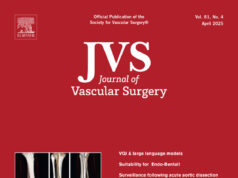
Patients who underwent reinterventions after fenestrated and branched endovascular aneurysm repair (F-BEVAR) had improved long-term survival over those who did not undergo a secondary operation, a large study of all investigational device exemption (IDE) F-BEVAR procedures carried out at nine U.S. medical centers from 2005-2020 found.
The consortium of researchers further discovered after analysis that major, minor and low magnitude reinterventions were associated with improved survival but that high magnitude reinterventions were not. The investigators classified all reinterventions performed after the initial procedure as either open or percutaneous and as major or minor according to Society for Vascular Surgery (SVS) reporting standards. However, the consortium went further by designating the secondary procedures as either high or low magnitude depending on the physiologic impact of the intervention. Sara L. Zettervall, MD, an assistant professor of surgery at the University of Washington School of Medicine in Seattle, delivered the findings during Plenary Session 5 at VAM on Aug. 21.
There are limited data on long-term outcomes after F-BEVAR for thoracoabdominal and juxtarenal aneurysms, despite an increasing number of fenestrated and branched procedures being performed, said Zettervall. Against this backdrop, Zettervall and colleagues set out to evaluate mortality after secondary intervention following F-BEVAR, the effect on long-term survival and which interventions carried the most risk by studying all patients enrolled in nine physician-sponsored IDEs. Of the 1,700 F-BEVAR cases included in the study, 23% were found to have involved a secondary intervention and 6% multiple.
Reintervention technical success was “very high at 96%,” she told VAM attendees, while mortality was recorded at just 1%. “When we looked at timing of these reinterventions, a quarter of all reinterventions occurred in the first 30 days, and this accounts for the majority of all high magnitude reinterventions,” Zettervall said. “Furthermore, 50% of all reinterventions happened within the first six months. When we looked at reinterventions over time, freedom from secondary intervention was 82% at one year. However, this decreased to 59% among patients with complete five-year follow-up.”
Those patients who ultimately required secondary intervention after F-BEVAR had undergone more complex initial procedures and had more complex anatomy, Zettervall and colleagues found. In terms of secondary interventions carried out in a percutaneous fashion, the treatment of target vessels accounted for more than half.
“This was followed by proximal and distal extension, which is of particular importance because these account for large-bore sheath interventions,” said Zettervall, who explained that a key difference between the SVS reporting standards and the consortium’s high-low magnitude classification system involved large-bore sheath access. This type of access “accounts for a large proportion of major reinterventions according to SVS reporting standards but was not considered a high magnitude reintervention in our new classification system,” she explained.
As for open reinterventions, “access-type complications were by far the most common,” followed by bypass and bowel resection. Open, high magnitude and major reinterventions accounted for a small proportion of all interventions performed, Zettervall said, pointing out that the elimination of large-bore sheath access in high magnitude reinterventions accounted for about 10% of major reinterventions. In sum, long-term survival in patients who underwent secondary intervention was improved, the study found, with no difference detected in terms of aortic-related mortality.
“When we utilized our SVS reporting standards, we did find differences in aortic-related mortality as well as survival, with those patients who underwent no reinterventions performing worse,” said Zettervall. “When we finally assessed using magnitude, the trends became even more clear: We found patients with low magnitude reinterventions performed by far the best among patients in terms of aortic-related mortality as well as all-cause survival. On adjusted analysis, again we saw that reinterventions were protective for all-cause mortality. However, when we looked specifically at aortic-related mortality, we found that high magnitude operations did have an adverse effect on survival, while low magnitude interventions were protective.”
Zettervall concluded that “a significant level of reintervention does not negatively impact survival. Rather, a reasonable rate of reintervention may be a marker for adequate follow-up.”












